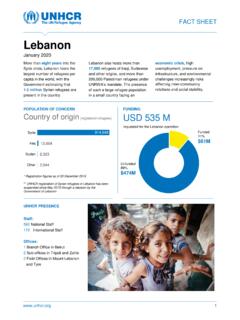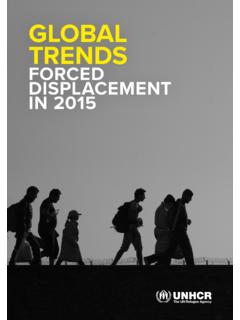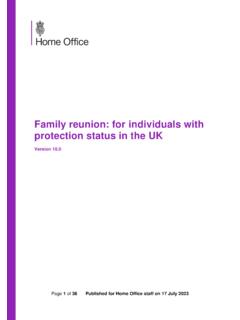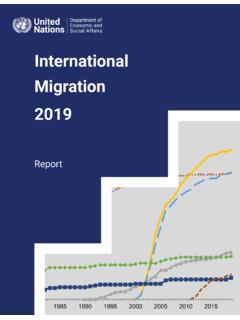Transcription of Migration and Health: Key Issues - World Health Organization
1 Migration AND Health :KEY ISSUESThe Health problems of refugees and migrants are similar to those of the rest of the population, although some groups may have a higher prevalence. The most frequent Health problems of newly arrived refugees and migrants include accidental injuries, hypothermia, burns, gastrointestinal illnesses, cardiovascular events, pregnancy- and delivery-related complications, diabetes and hypertension. Female refugees and migrants frequently face specifi c challenges, particularly in maternal, newborn and child Health , sexual and reproductive Health , and violence.
2 The exposure of refugees and migrants to the risks associated with population movements psychosocial disorders, reproductive Health problems, higher newborn mortality, nutrition disorders, drug abuse, alcoholism and exposure to violence increase their vulnerability to noncommunicable diseases (NCDs). The key issue with regard to NCDs is the interruption of care, due either to lack of access or to the decimation of Health care systems and providers; displacement results in interruption of the continuous treatment that is crucial for chronic conditions. Vulnerable individuals, especially children, are prone to respiratory infections and gastrointestinal illnesses because of poor living conditions, suboptimal hygiene and deprivation during Migration , and they require access to proper Health care.
3 Poor hygienic conditions can also lead to skin infections. Furthermore, the number of casualties and deaths among refugees and migrants crossing the Mediterranean Sea has increased rapidly, with over 3100 people estimated to have died or gone missing at sea in the fi rst 10 months of 2015, according to the United Nations High Commissioner for refugees (UNHCR). In spite of the common perception of an association between Migration and the importation of infectious diseases, there is no systematic association. Communicable diseases are associated primarily with poverty. Migrants often come from communities affected by war, confl ict or economic crisis and undertake long, exhausting journeys that increase their risks for diseases, which include communicable diseases, particularly measles, and food- and waterborne diseases.
4 The European region has a long experience of communicable diseases such as tuberculosis (TB), HIV/AIDS, hepatitis, measles and rubella and has signifi cantly reduced their burden during economic development, through better housing conditions, access to safe water, adequate sanitation, effi cient Health systems and access to vaccines and antibiotics. These diseases have not, however, been eliminated and still exist in the European region, independently of Migration . This is also true of vector-borne diseases in the Mediterranean area, such as leishmaniasis, with outbreaks recently reported in the syrian Arab Republic.
5 Leishmaniasis is not transmitted from person to person and can be effectively treated. Typhoid and paratyphoid fever are also registered in the European region; the vast majority of cases in the European Union are related to travel elsewhere. The risk for importation of exotic and rare infectious agents into Europe, such as Ebola, Marburg, Lassa and Middle East respiratory syndrome (MERS) viruses, is extremely low. Experience has shown that, when importation occurs, it involves regular travellers, tourists or Health care workers rather than refugees or migrants. WHO Regional Offi ce for EuropePublic Health Aspects of Migration in EuropeRefugees and migrants: common Health problems Migration and communicable diseases: no systematic associationMigrants risk for being infected or developing TB depends on: the TB incidence in their country of origin; the living and working conditions in the country of immigration, including access to Health services and social protection; whether they have been in contact with an infectious case (including the level of infectiousness and how long they breathed the same air).
6 And the way they travelled to Europe (the risk for infection is higher in poorly ventilated spaces). People with severe forms of infectious TB are often not fi t to travel. The incidence of TB in the countries of origin varies from as low as 17 new cases per 100 000 population in the syrian Arab Republic to 338 in Nigeria. The average TB rate in the European Region is 39 per 100 000 population. TB is not easily transmissible, and active disease occurs in only a proportion of those infected (from 10% lifetime risk to 10% per year in HIV-positive people) and within a few months or a few years after infection. TB is not often transmitted from migrants to the resident population because of limited contact.
7 Confl ict and emergencies can disrupt HIV services; however, the prevalence of HIV infection is generally low among people from the Middle East and North Africa. Hence, there is a low risk that HIV will be brought to Europe by migrants from these countries. The proportion of migrants among people living with HIV varies widely in European countries, from below 10% in eastern and central Europe to 40% in most northern European countries; in western Europe, the proportion is 20 40%. Despite a decline during the past decade, migrants still constitute 35% of new HIV cases in the European Union and the European Economic Area; however, there is increasing evidence that some migrants acquire HIV after their arrival.
8 As many developing countries have a high burden of viral hepatitis, the increasing infl ux of refugees from highly endemic counties is changing the disease burden in Europe. refugees and migrants do not pose an increased threat for further spread of respiratory infections from, for example, infl uenza viruses, respiratory syncytial virus, adenovirus or parainfl uenza virus to the populations of the receiving countries, where these are common infections that circulate widely. However, physical and mental stress and deprivation due to lack of housing, food and clean water increase refugees risk for respiratory infections.
9 Infl uenza can cause severe disease in known risk groups (pregnant women, children under the age of 5 years, people with chronic underlying conditions and the elderly). WHO supports policies to provide seasonal infl uenza vaccine to risk groups, irrespective of their legal status. In line with WHO recommendations, most countries of the WHO European Region recommend seasonal infl uenza vaccination for Health care September 2012, 15 laboratory-confi rmed cases of MERS-CoV infection, with seven deaths, have been reported by eight countries in the WHO European Region. Most of the cases were imported and did not result in further spread of the virus.
10 The risk that another traveller infected with MERS-CoV will enter the European Region remains, but it is low. Most travellers to Europe do not transit through the countries currently reporting cases of infection with MERS-CoV; if they do, they will probably not use local hospitals. The only unknown factor is their likelihood of contact with camels and camel products. While the risk of a larger outbreak in European Union countries is considered small, the outbreak in the Republic of Korea earlier this summer demonstrates that this possibility cannot be risk for reintroduction and localized outbreaks of vector-borne diseases such as malaria and leishmaniasis can be increased by a mass infl ux of refugees , as seen by the recent resurgence of malaria in Greece that was directly linked to an infl ux of migrants from Pakistan.

















